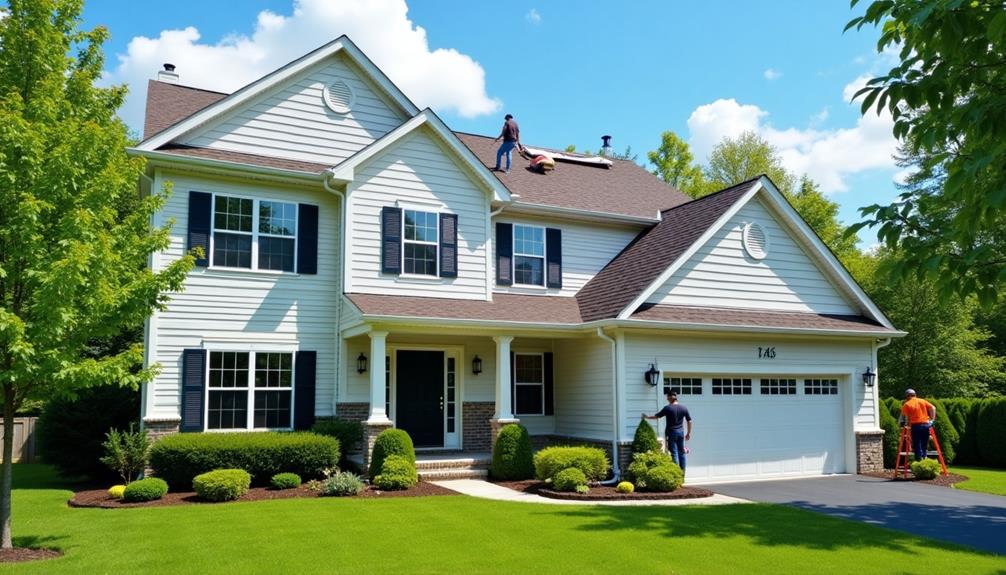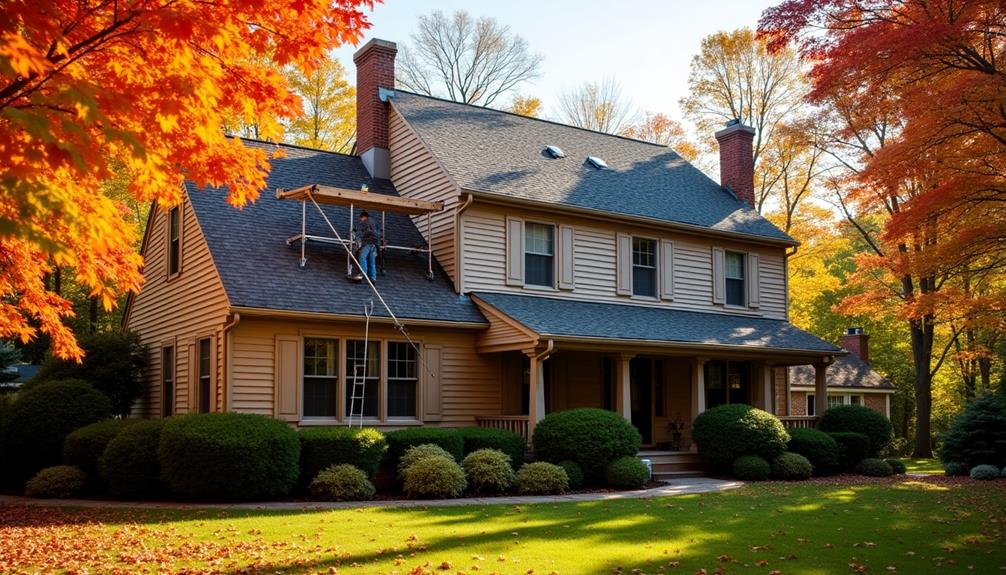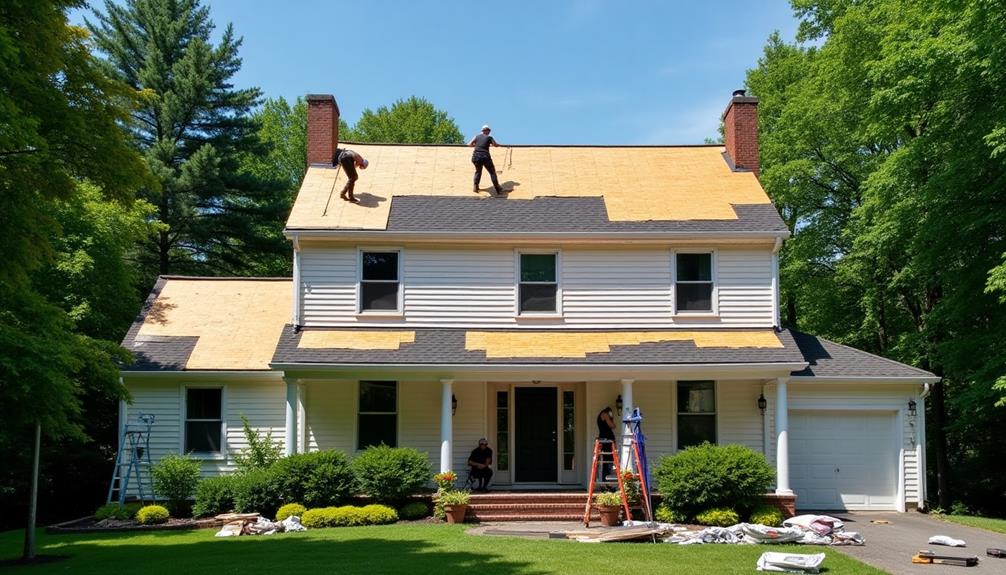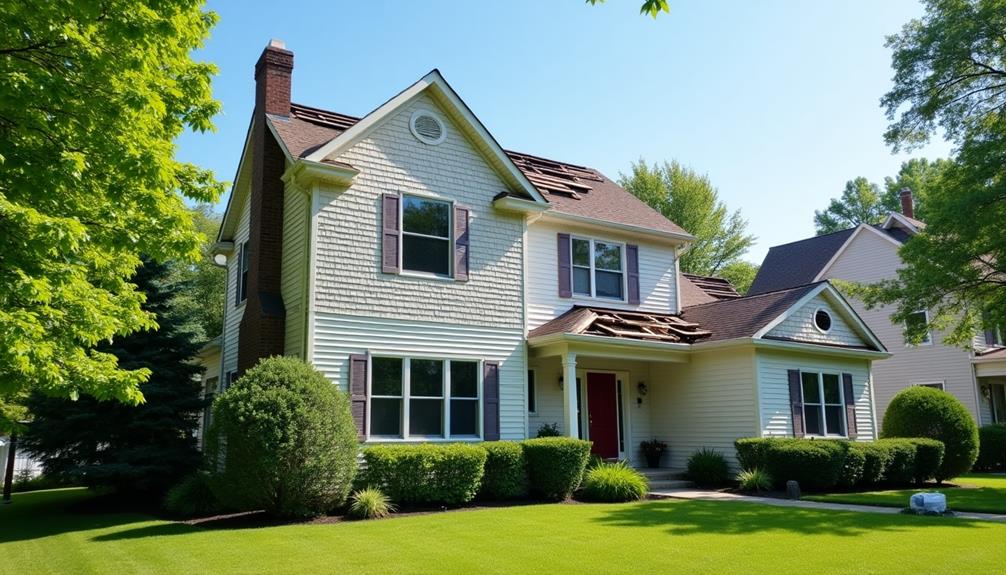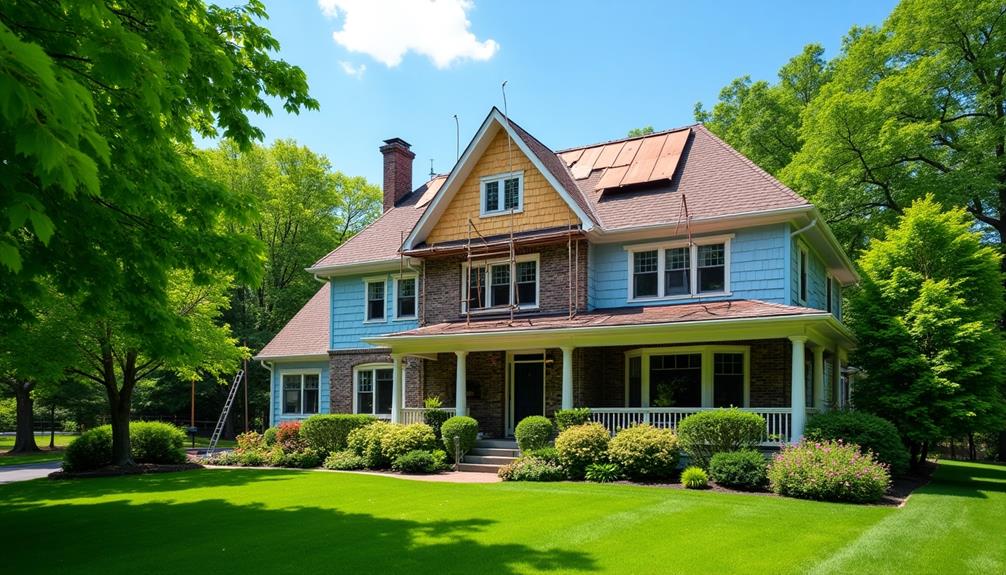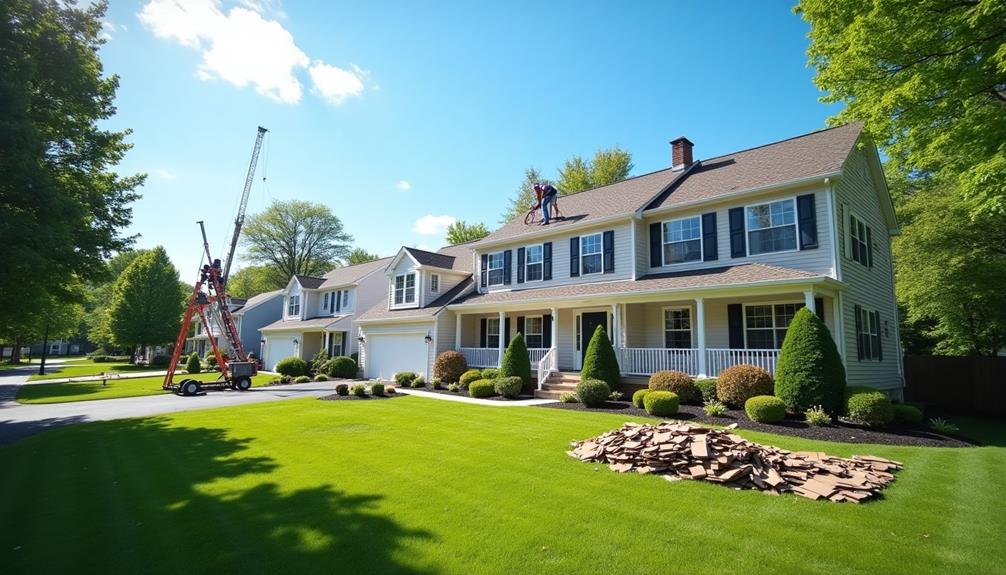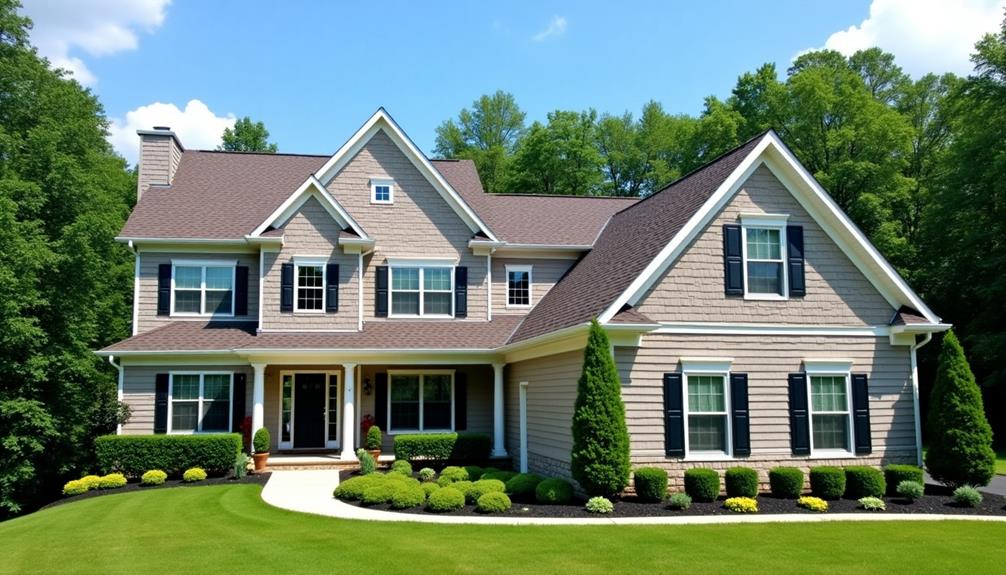If you're considering roof replacement in Mount Holly, NJ, you'll want to assess signs like leaks, granule loss, or curling shingles. A new roof enhances energy efficiency, boosts curb appeal, and strengthens your home's structure. Choosing durable materials suited to local weather conditions is essential for longevity and performance. Budgeting effectively for the project, including materials and labor, is key to a successful outcome. It's also crucial to select a reliable contractor who offers comprehensive warranties. You can ensure a smoother process by understanding each step involved in roof replacement and exploring your options further.
Signs You Need a Replacement
Recognizing the signs that indicate you need a roof replacement is crucial for maintaining the integrity of your home. One of the primary indicators is the presence of leaks. If you notice water stains on your ceilings or walls, it's essential to conduct leak detection immediately. These leaks might suggest significant damage, such as cracked shingles or a compromised underlayment, which can lead to more severe issues if not addressed promptly.
Another sign to watch for is granule loss. If you find granules in your gutters or downspouts, it's a clear indication that your roof is deteriorating. This granule loss can severely impact your roof's energy efficiency, as it reduces the ability to reflect sunlight and insulate your home effectively.
Additionally, inspect for curling or buckling shingles, which can signify that your roof has reached the end of its lifespan. If you see daylight through your roof boards, it's also a strong indicator that a replacement is necessary.
Being proactive about these signs can save you time and money, ensuring your home remains safe and energy-efficient.
Benefits of Roof Replacement
When considering a roof replacement, you can expect a range of benefits that significantly enhance your home's value and functionality. One of the foremost advantages is improved energy efficiency. A new roof often comes with advanced materials and insulation that effectively reduce heat loss during winter and keep your home cooler in summer. This can lead to lower energy bills and a more comfortable living environment year-round.
Additionally, a roof replacement can dramatically boost your home's aesthetic appeal. Whether you opt for modern shingles, tiles, or metal roofing, the right choice won't only refresh your home's exterior but also increase its curb appeal. This is particularly important if you're considering selling your property in the future, as a visually appealing roof can attract potential buyers and increase your home's market value.
Moreover, a new roof enhances your home's structural integrity, protecting it from water damage, mold growth, and other issues associated with aging roofing materials.
Ultimately, investing in roof replacement is a strategic decision that combines practicality with aesthetic enhancements, ensuring your home remains safe, efficient, and visually appealing for years to come.
Choosing the Right Materials
When selecting materials for your roof replacement, consider both durability and cost-effectiveness.
You'll want to evaluate how each option balances initial investment against long-term longevity.
Understanding these factors will help ensure you make an informed decision that meets your home's needs.
Material Durability Considerations
Selecting the right roofing materials is crucial for ensuring long-term durability and performance. You'll want to consider the material lifespan, as this directly impacts the frequency of replacements and maintenance. For example, asphalt shingles typically last 15 to 30 years, whereas metal roofing can exceed 50 years. Choosing a material with a longer lifespan often means lower long-term costs.
Weather resistance is another vital factor. Your roof must withstand local climate conditions, including heavy rain, snow, and UV exposure. Materials like slate and metal offer superior weather resistance, while traditional asphalt may require more frequent repairs in harsh conditions.
Additionally, consider the material's wind resistance; roofing that can endure high winds will reduce the risk of damage during storms.
It's essential to evaluate the specific environmental factors in Mount Holly, NJ, and select materials that align with those challenges. By focusing on durability and performance characteristics, you'll make a more informed decision that enhances your roof's longevity and resilience.
Cost vs. Longevity Analysis
Balancing cost and longevity is essential for making informed roofing material choices. When you're considering a roof replacement in Mount Holly, NJ, it's crucial to evaluate the cost factors associated with different materials alongside their longevity expectations.
For instance, asphalt shingles may present a lower upfront cost but typically last around 20 years, while metal roofing, though initially more expensive, can endure for 50 years or more.
Understanding the trade-offs is key. Higher-quality materials often come with increased durability, which means fewer replacements and repairs over time. This can lead to significant savings in the long run, countering the higher initial investment.
Additionally, consider the local climate and environmental conditions in Mount Holly, as these can affect material performance and longevity.
You should also factor in warranty coverage, as more extended warranties often indicate a manufacturer's confidence in their product's durability.
Ultimately, selecting roofing materials entails a careful analysis of both cost factors and longevity expectations, ensuring that your investment not only fits your budget but also safeguards your home for years to come.
Local Climate Considerations
As you consider roof replacement in Mount Holly, NJ, it's crucial to factor in the local climate. The area's weather patterns significantly influence the materials and methods you'll choose for your new roof.
With hot summers and cold winters, your roofing system must withstand thermal expansion and contraction, which can lead to premature failure if not properly addressed.
During the summer months, heavy rainfall and humidity can create conditions conducive to mold and mildew growth. Selecting materials with enhanced moisture resistance will help mitigate these seasonal impacts.
In contrast, winter brings snow and ice, necessitating a roofing system that can handle the additional weight and prevent ice dam formation.
Moreover, Mount Holly experiences occasional severe storms. Choosing durable materials designed to resist high winds will be beneficial.
Asphalt shingles, metal roofing, or tiles can provide varying levels of resilience against such weather extremes.
Ultimately, understanding how local climate conditions affect your roofing options ensures you invest in a system that offers longevity and protection, tailored to the unique challenges of Mount Holly's environment.
Budgeting for Your Project
When planning your roof replacement project in Mount Holly, NJ, it's essential to establish a clear budget that encompasses all aspects of the undertaking.
Start by assessing the costs of materials, labor, and any necessary permits. This helps you avoid unexpected expenses down the line.
Next, explore various financing options. Many contractors offer payment plans or financing through third-party lenders, which can ease the financial burden.
It's crucial to understand the terms and interest rates associated with these options to make an informed decision.
Additionally, check your insurance coverage. Homeowner's insurance may cover part of the costs if your roof was damaged due to a covered event, like a storm or fire.
Contact your insurance provider to clarify what's included and what documentation you'll need to submit for a claim.
Finding a Reliable Contractor
Trust is crucial in finding a reliable contractor for your roof replacement in Mount Holly, NJ. Start by verifying contractor credentials, including licenses, insurance, and bonding. A qualified contractor should provide proof of these credentials, ensuring they meet state and local regulations. This verification protects you from potential liabilities during the project.
Next, gather multiple quotes from various contractors. This not only helps you compare pricing but also gives insight into their professionalism and communication skills. Pay attention to the details in the proposals, including the materials they intend to use and their warranty offerings.
Another important aspect is discussing project timelines. A reputable contractor should be able to provide a clear and realistic timeline for the work, outlining key milestones and completion dates. This transparency helps set your expectations and can prevent misunderstandings during the project.
The Replacement Process
The roof replacement process involves several critical steps that ensure the durability and longevity of your new roof. First, you'll need a thorough roof inspection to assess the current condition and determine the extent of the replacement. This inspection helps identify underlying issues, such as water damage or structural problems, that could affect the new installation.
Once the inspection is complete, you can establish a project timeline. This timeline outlines each phase of the replacement, from removing the old roofing material to installing the new one. The following table summarizes the key steps and their estimated durations:
| Step | Estimated Duration |
|---|---|
| Roof Inspection | 1 day |
| Material Selection | 1-2 days |
| Old Roof Removal | 1-3 days |
| New Roof Installation | 2-5 days |
After setting the project timeline, your contractor will prepare the worksite and ensure everything is aligned with local building codes. By following this structured process, you'll ensure a successful roof replacement that meets your needs and expectations.
Maintenance Tips After Replacement
To keep your new roof in optimal condition, regular maintenance is essential. Start with post-replacement inspections. Within the first few months after installation, carefully check for any signs of damage or improper installation, such as loose shingles or flashing issues. Address these immediately to prevent further complications.
Seasonal upkeep is equally important. In the spring and fall, inspect your roof for debris accumulation, such as leaves and branches that can trap moisture. Clear the gutters and downspouts to ensure proper drainage. This helps prevent water damage and extends your roof's lifespan.
During winter, check for ice dams, which can cause significant damage. Ensure your attic is properly insulated and ventilated to mitigate this risk.
Additionally, consider scheduling professional inspections annually. Experts can identify potential issues that may go unnoticed, allowing for timely repairs.
Always document maintenance activities and inspections to maintain a thorough record, which can be beneficial for warranty claims or future property transactions.

